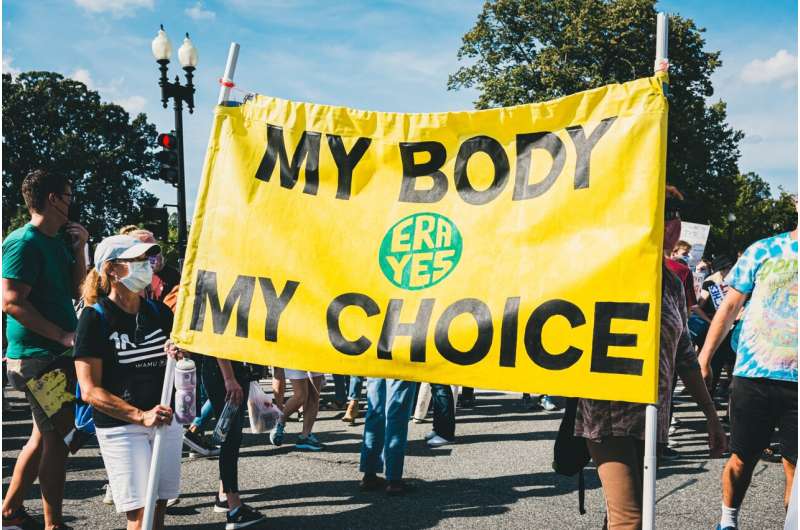Opinion: White men have controlled women's reproductive rights throughout US history and post-Dobbs era is no different

More than a year after the Supreme Court ended federal protection for abortion rights in the United States, disagreements over abortion bans continue to reverberate around the country. during the Aug. 23, 2023, Republican presidential debate. And abortion is likely to figure prominently in the November 2023 .
When the U.S. Supreme Court overturned in June 2022, removing women's federal constitutional right to get abortions and giving states the power to pass laws about the legality of the procedure, the 6-3 vote was by a four white men, one Black man and a white woman majority.
Since that decision——more than , have voted for full or partial abortion bans.
This is not the first period in U.S. history when white men have exercised control over women's right to bear—or not bear—children, including during slavery. Then, it was a matter of numbers. The more people they enslaved, the more money white male enslavers could earn either from of the enslaved. , too, with the .
From the late 1800s until the 2000s, white proponents of eugenics—the selective breeding of people—tried to determine who was fit or unfit to have children. While the American eugenics movement affected people of other races and ethnic backgrounds, as well as men, it was particularly harmful to Black women who, data from 1950 to 1966 shows, were sterilized at "three times the rate of white women and more than 12 times the rate of white men."
During both periods, of white men's control.
As a researcher who specializes in the , I study historical issues related to race, gender and social justice.
Enslaved women forced to reproduce
, imported and enslaved as early as the 1600s, attended to the birthing needs of the until the beginning of the 19th century.
But, after 1808, enslavers in the United States enslaved people. With this shift, enslavers stepped up the . White men raped the Black women and, and then enslaved the children born from those rapes. White men also with one another to generate more babies, who would be born into slavery.
of ensuring enslaved women for their enslavers.
Because of using birth control and abortions to resist forced pregnancy and the enslavement of their offspring, enslavers turned increasingly away from midwives and to to figure out why nearly half of enslaved infants were stillborn or died within their first year of life and why so many enslaved women were infertile. .
In the two decades after 1810, the , despite the ban on slave importation. This was just under the 1800 to 1809 average of 31.6% which was a century high.
In the 1800s, as the slave population increased, . And after the legal importation of slaves ended, the significantly. The forced breeding of these enslaved women was .
Eugenics and control over women's bodies
Eugenicists believed that increased breeding by white people, whom they assumed had high IQs, would benefit American society. But people who did not embody their idea of racial perfection, such as Black people, Native Americans, certain immigrants, poor white people and people with disabilities, should be sterilized—typically via .
In this , eugenicists often to determine who was fit or unfit to reproduce and to predict who would commit crimes, end up in poverty or have children who were mentally ill or intellectually disabled. And they worked to incorporate their ideas into state laws.
, between 1907 and 1937, enacted forced sterilization mandates to prevent births by people eugenicists considered socially inadequate.
State-mandated procedures resulted in the coerced sterilization of women, particularly , and .
with President Harry Truman's executive order to integrate the military, which extended to other areas, including education, employment and commerce, sterilization rates for Black women increased. For example, in North Carolina, which had the country's third-highest sterilization rate, far more women than men were forcibly sterilized. And in the 1960s, , while only making up 25% of the population.
, close to 33% of the women in Puerto Rico, a U.S. territory, were forcibly sterilized. In California, between 1997 and 2003, 1,400 female inmates, .
The post-Dobbs era
White nationalists and some right-wing politicians in the U.S. see the nation's demographic changes as dangerous. The Census Bureau , non-Hispanic white people will no longer make up a majority of the U.S. population. The nation's racial and ethnic makeup will then be what some call "." Those projections scare racists, , which they label the because they fear losing social, political and economic power.
There is no way to know if this theory factored into the majority's votes in the Dobbs decision, but the argument that has been a in the American anti-abortion movement.
But, while believers in the great replacement conspiracy want white women to have more babies, actual anti-abortion decisions like the Dobbs ruling than any other group. Black women represent 39% of the country's abortion patients, but many live in communities that have limited access to . And they have higher rates of complications during pregnancy.
As a result, Black women—who experience and mortality rates—.
This is another period in the country in which the reproductive health decisions made by mostly white men will harm Black women.
Provided by The Conversation
This article is republished from under a Creative Commons license. Read the .![]()

















